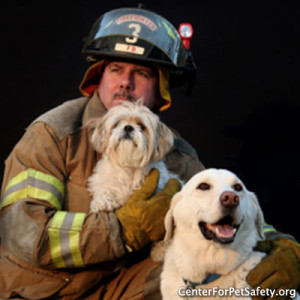In honor of National Pet Fire Safety Day, Center for Pet Safety has put together the following list of practical tips and free downloads to help families prevent pets from causing fires. Being prepared for any emergency is mission critical and will help you save the life of your family and your pets. Please take a moment and learn how Center for Pet Safety helps you be prepared.
Window Clings and Identification – Installing a window cling on the front window of your home is a simple way to help to notify First Responders that your pets are inside. However, that’s not everything you’re going to need in an emergency. You should also keep ample identification aids (including images of you with your pet and microchip id), medical records, and county registration records in an easy to access off-site location – like a neighbor’s house. Also the contact information of veterinary, and the nearest emergency veterinarian is something to keep with your records. While you’re at it, think about keeping a copy in your vehicle glove box too – because accidents happen.
Center for Pet Safety’s PAWS UP for Safety® program has a link to download a free vet record book. https://www.centerforpetsafety.org/pet-parents/paws-up-for-safety/vet-record-booklet/
Practice, Practice, Practice – Practicing the emergency escape route with your pets frequently will help them to understand where they need to go in the event of a fire. We also recommend training with a special keyword as a cue – (ie: “Quick, Quick, Quick!” in an excited, yet commanding voice). Put them on a leash, and calmly walk them through the route – all while using your keyword. Once you’re done – lots of pets and praise for a job well done will help reinforce the drill. Repeat this drill frequently. Eventually, through repetition, your pets will understand that when you use that keyword series, they’ll know exactly where to go.
Pets Panic – Firefighters recommend that you keep pets near front entrances of your home when you leave. That would entail confining them to a front room or crating them while you’re gone. This practice helps keep pets close to an exit – and makes it much easier for First Responders to get your pets out safely when you’re not home.
Pets Can Cause Fires – Keeping your pets away from open flames (candles) or things like stove knobs and wiring can help prevent your pet from starting a fire. Just think about it – you leave a sandwich on the counter and your dog jumps up to get it. They can do the same thing at the stove – except when they reach up, their paw hits the knob and turns on the stove, or turns on the gas without lighting it. Keeping pets away from cooking areas and keeping food well away from the stove top will help avoid any future problems.
Cats, kittens, puppies and house rabbits are known to be chewers. There are wiring covers and automatic winders that contain electric cords you can buy at your local hardware store. These products are inexpensive and are very easy to install. Remember, there is simply no substitute for supervision when you have a young pet in the house – they need to be monitored and corrected to stay out of trouble.
Smoke and CO2 Detectors – You’ve probably already got them in your home – but you’ll want to change the batteries and test them once a year. Having several working fire and CO2 detectors in the home will alert you in the case of an emergency, and is a good way for neighbors to know if something is wrong when you are away.
And while we’re talking about household disasters, it’s always good to be prepared for anything that comes your way. Center for Pet Safety’s PAWS UP for Safety® program has published this handy guide to help the entire family prepare for emergencies. https://www.centerforpetsafety.org/pet-parents/paws-up-for-safety/be-prepared/
Safety First! PAWS UP!!
The Center for Pet Safety Team


Comments are closed.